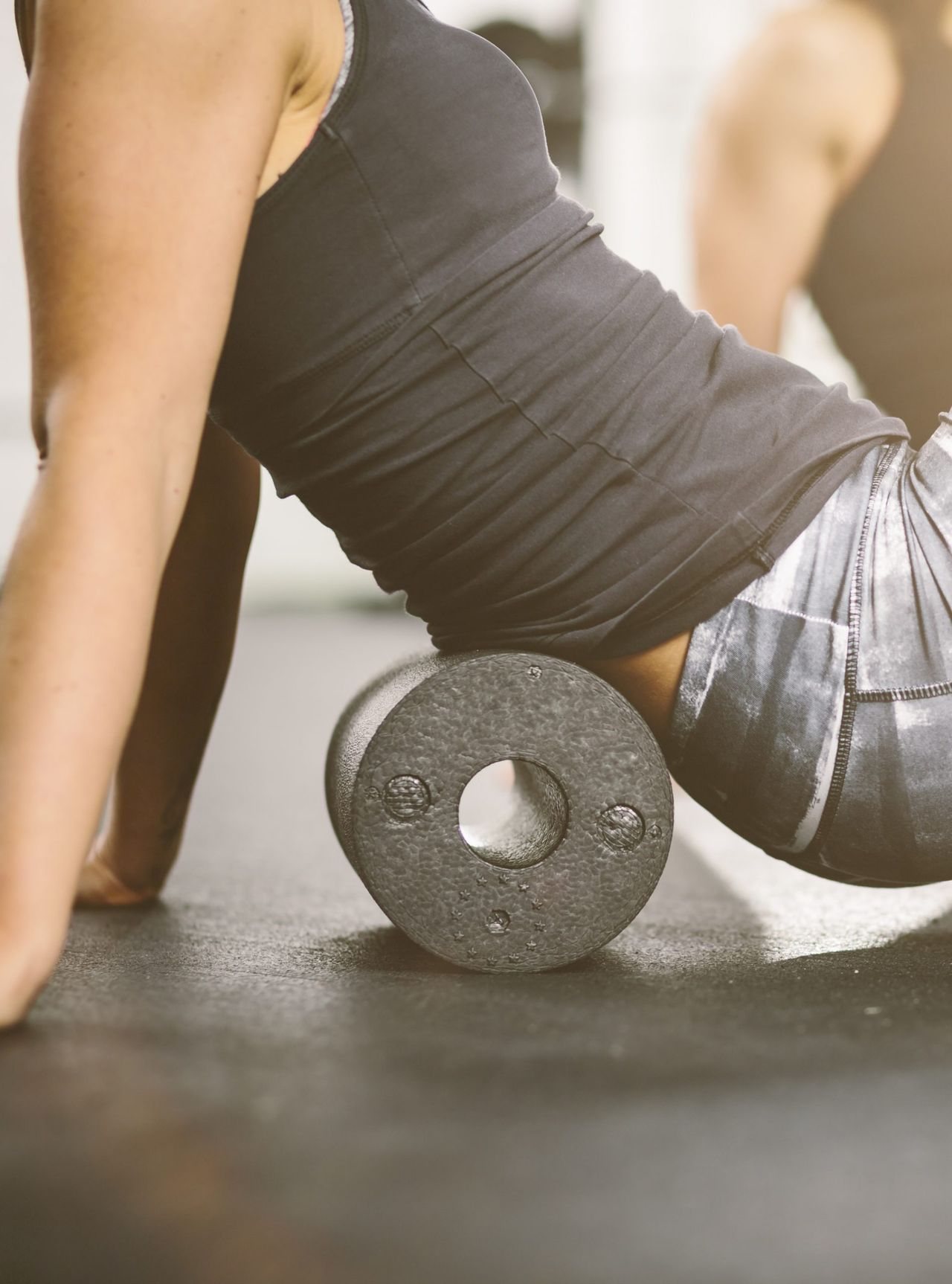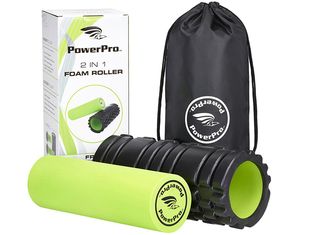How To Use A Foam Roller

Foam rolling. Everyone seems to be at it, but what exactly is it? Does it have any benefits for those of us who don't spend every other waking hour in the gym? Can it really cure cellulite? And, if so, where do you sign up?
Don't worry, we have the answers to all your queries and quandaries. Find out what it is, why you should be doing it, and how to get started with our complete guide to foam rolling for beginners...
What is foam rolling?
Foam rolling is essentially a form of D.I.Y. deep tissue massage which uses a combination of bodyweight and a firm foam cylinder. Foam rollers may be smooth (ideal for beginners and delicate areas) or textured (to really target ‘trigger points'). Its official name is self-myofascial release. Fascia is the connective tissue which covers and connects our muscles, organs and nerves. Comprised of collagen fibres, this is essentially what holds us together, "like plastic wrap," in the words of one expert. The over or underuse of certain muscles thanks to poor posture, habitual patterns of movement, exercise (or a lack thereof) or injury can cause the fascia to become sore and restricted. Foam rolling devotees believe that, where stretching fails, foam rolling can release the resulting 'knots' or ‘trigger points'. It's not an exact analogy, but imagine, if you will, a rubber band with a knot in the middle. Stretching the band will lengthen it (albeit temporarily) but won't untangle the knot. In fact, it may pull it tighter. According to its fans, though, foam rolling can actually work these knots out. Scientists suggest that foam rolling may work by "firing up the central nervous system" in response to signals sent by our pain receptors (we won't lie, it can hurt a little) and not directly on the fascia itself. However, few dispute the fact that, however it works, it works.
Benefits of foam rolling
- Releases muscular knots caused by over or underuse, poor posture or stress
- Breaks down adhesions and scar tissue caused by old injuries which haven't healed properly
- Helps with upper and lower back pain
- Can relieve knee pain caused by the muscular knots or ‘trigger points' in other areas of the body which ‘refer' pain to the knee area
- Enhances flexibility, posture and mobility
- Improves blood flow
- May improve the appearance of cellulite
- Reduces stress andcortisollevels
- Improves muscular function, enhancing the effectiveness of your workout
- Helps to prevent injury
- Speeds up post-workout recovery
How to use a foam roller
When should I use a foam roller?
If you run, weight train or practise yoga, you can use a foam roller as part of your regular warm-up and/or cool down routines. Foam rolling for 5-10 minutes pre-workout can improve circulation, enabling muscles to work more efficiently and helping to prevent injury. Foam rolling after a workout, helps to relieve muscular tension, disperse toxins and kickstart the recovery process. Experts suggest you roll problematic areas before you exercise, and all major muscle groups after a workout, spending 1-2 minutes on each muscle group.
If you don't have a regular exercise regime, you can still benefit from foam rolling. Why not take 5-10 minutes out of your day to foam roll before bed? You could even do it in front of the TV.
How do I choose the right foam roller?
Sign up for the woman&home newsletter
Sign up to our free daily email for the latest royal and entertainment news, interesting opinion, expert advice on styling and beauty trends, and no-nonsense guides to the health and wellness questions you want answered.
We suggest starting off with a smooth-surfaced, softer roller. Once you become accustomed to the process and sensations, you might like to try a firmer, textured roller for a deeper massage, or to target certain trigger points. Cover all bases with a 2-in-1 foam roller set.
PowerPro 2 In 1 Foam Roller, £19.97, G2 Sportswear

Buy now from amazon.co.uk for £19.97
How do I use a foam roller?
Lie on the roller (the area of your body which should be in contact with the roller will depend upon the muscles you are targeting) using your arms to support you. Try to allow your body to relax, releasing your bodyweight onto the roller. You can use your arms to alter the intensity - if it hurts, ease off; if you don't feel anything, ease a little more weight onto the roller. Imagine that you are operating a giant rolling pin. Beginners should use lighter pressure over a wider contact area.
Roll up and down the length of the muscle until you come across an area which is sore or tight. Roll slowly, at a rate of no more than one inch per second. Go too fast and you won't give your muscles enough time to fully relax. When you encounter a knot or trigger point, take a deep breath, pause and relax for 3-5 seconds, taking a continuous exhalation as you imagine the muscle releasing. Repeat 5-10 times before moving on to explore other trouble spots. Roll side to side, as well as up and down, to release these 'sticking points'. Feelings of discomfort may increase at first, but should begin to disperse within 5-30 seconds. Trainers recommend slowly building up from 20 to 90 seconds per area. Don't foam roll the same area for longer than 2 minutes, as this could cause tissue bruising, and avoid rolling bones.
Foam rolling may feel uncomfortable, but should not be unbearable. If you experience pain, don't roll the area directly. Instead, work around the sore spots before using larger, sweeping motions to roll the entire area (the shorter the stroke, the deeper its effects). It's well worth targeting those trouble spots indirectly anyway. "Areas of pain are the victims that result from tension imbalances in other areas of the body," says Sue Hitzmann, author of The Melt Method. Did you know that tight calves can cause lower back pain, for example? You should also roll larger muscle groups in order to reap the full benefits of foam rolling.
You may feel sore the day after foam rolling, as if your muscles have been worked. Don't worry. Drinking lots of water, getting enough sleep and eating well will aid recovery.
When should I avoid foam rolling?
- Wait 24-48 hours before rolling the same area again.
- Avoid foam rolling a recent injury or area in which you are experiencing sharp pain. Rolling an inflamed area can increase inflammation, doing more harm than good.
- Consult your doctor if you are taking blood thinning medication or suffer from an autoimmune disease like lupus or rheumatoid arthritis. You should not foam roll when experiencing a flare-up.
Foam rolling exercises
Best foam rolling exercises for cellulite
Alignment expert Lauren Roxburgh, who has trained Gwyneth Paltrow, says foam rolling can blitz cellulite by enhancing lymphatic drainage, flushing toxins from the body and strengthening the fascia, comparing it to "an internal juice cleanse". She suggests combining these foam rolling exercises with dry body brushing for optimum results:
IT Band Roll
"Hips are susceptible to blockages, tightness and rigidity, and are a common area of tension and stress," says Roxburgh, especially if we spend most of the day sitting down.
Lie on one side with the roller resting under your thigh, just beneath your hip. Bend your top leg, resting your foot on the floor in front of your other leg. Rest your forearm on the floor. You can place your other hand on the floor, or on your hip to increase intensity. Slowly roll up and down your outer thigh, spending 30-60 seconds on each hip. Stack your top leg on top of your bottom leg to increase the pressure.
Piriformis Roll
Sit on the roller with one foot on the ground and cross the other ankle over the opposite knee. Support yourself by placing your hands on the floor behind you. Lean into the buttock on the grounded leg and slowly roll forward and back. Grasp your top ankle with one hand to increase the pressure. Repeat on the opposite side.
Front Hip Roll
Lie on your front, forearms flat on the floor. Place the roller underneath your hips, keeping your feet together and hips wide. Slowly roll your body forward and back so that the roller moves up and down the length of your thighs. Engage your core muscles to stabilise you and prevent your lower back from arching.
Best foam rolling exercises for knee pain
Rolling the major muscle groups which surround the knee can alleviate knee pain by targeting trigger points which may be referring pain to the knee area. In addition to the IT Band roll exercise, above, try the following exercises:
Hamstring Roll
Sit on the roller, legs straight out in front of you, supporting yourself by placing your hands on the floor behind you. Slowly roll from the buttocks to the knees. Increase the pressure by working on one leg at a time, crossing the other leg on top at the ankle. Pause on any tight or painful areas.
Quadricep Roll
Lie on your front, supporting yourself on your forearms. Place the roller under your hips, keeping your legs straight and core engaged. Rock forward and back so that the roller travels slowly back and forth between your hips and your knees. Pause on any tight or painful areas, remembering not to roll your knees directly.
Best foam rolling exercises for runners
Runners will benefit from rolling the piriformis, IT Band and calf muscles before a run, and targeting the hamstrings, quads and adductors (inner thighs) as part of their cool down.
Calf Roll
Sit on the floor with one knee bent, foot flat on the floor, placing your hands on the floor behind you for support. Place your other calf on the roller. Keeping the leg straight, roll from the knee to the ankle, slowly rotating the leg in, then out. To add pressure, stack the other leg on top, crossing your ankles.
Adductor Roll
Lie on your front, bending one knee and extending it slightly to the side. Place the roller underneath this leg and slowly roll the inner thigh. Support yourself on your forearms.
Foam rolling your lower back
80% of adults will experience lower back pain at some point. However, foam rolling your lower back directly is a big no-no, according to most experts. "Your spine will freak out and all the spinal muscles will contract and protect the spine," The Melt Method's Sue Hitzmann warns. In fact, rolling your lower back could aggravate, rather than ease, your pain!
You can foam roll your upper back, but should avoid the area below the ribcage. Foam rolling the glute, piriformis, IT band, hip, quad and calf muscles may also ease lower back pain, since tightness in these areas can radiate to the lower back area.
-
 Katie Holmes broke an unspoken fashion rule in tights and mules - her shoes are available for less than £100 on Amazon
Katie Holmes broke an unspoken fashion rule in tights and mules - her shoes are available for less than £100 on AmazonThe statement gold kitten heels are a surprisingly versatile spring staple
By Charlie Elizabeth Culverhouse Published
-
 The diet linked to longer and better sleep, revealed by new study
The diet linked to longer and better sleep, revealed by new studyThe study looked at data from tracking apps to see what foods were more likely to lead to better sleep
By Kat Storr Published